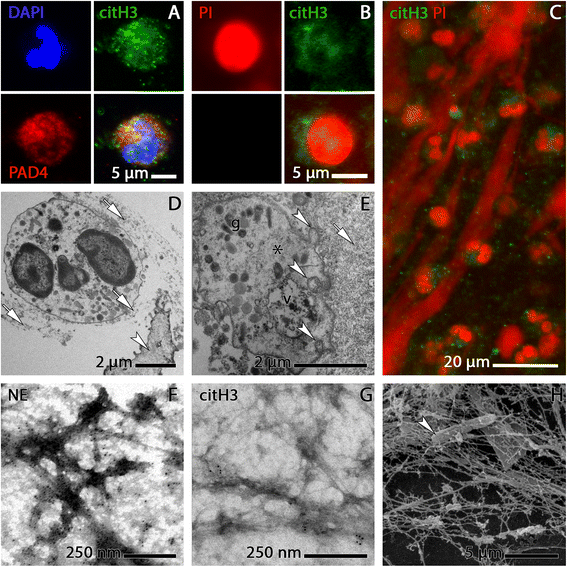Neutrophil extracellular trap (NET) formation characterises stable and exacerbated COPD and correlates with airflow limitation
- PMID: 25994149
- PMCID: PMC4455316
- DOI: 10.1186/s12931-015-0221-7
Neutrophil extracellular trap (NET) formation characterises stable and exacerbated COPD and correlates with airflow limitation
Abstract
Background: COPD is a progressive disease of the airways that is characterized by neutrophilic inflammation, a condition known to promote the excessive formation of neutrophil extracellular traps (NETs). The presence of large amounts of NETs has recently been demonstrated for a variety of inflammatory lung diseases including cystic fibrosis, asthma and exacerbated COPD.
Objective: We test whether excessive NET generation is restricted to exacerbation of COPD or whether it also occurs during stable periods of the disease, and whether NET presence and amount correlates with the severity of airflow limitation.
Patients, materials and methods: Sputum samples from four study groups were examined: COPD patients during acute exacerbation, patients with stable disease, and smoking and non-smoking controls without airflow limitation. Sputum induction followed the ECLIPSE protocol. Confocal laser microscopy (CLSM) and electron microscopy were used to analyse samples. Immunolabelling and fluorescent DNA staining were applied to trace NETs and related marker proteins. CLSM specimens served for quantitative evaluation.
Results: Sputum of COPD patients is clearly characterised by NETs and NET-forming neutrophils. The presence of large amounts of NET is associated with disease severity (p < 0.001): over 90 % in exacerbated COPD, 45 % in stable COPD, and 25 % in smoking controls, but less than 5% in non-smokers. Quantification of NET-covered areas in sputum preparations confirms these results.
Conclusions: NET formation is not confined to exacerbation but also present in stable COPD and correlates with the severity of airflow limitation. We infer that NETs are a major contributor to chronic inflammatory and lung tissue damage in COPD.
Figures



References
-
- Calik-Kutukcu E, Savci S, Saglam M, Vardar-Yagli N, Inal-Ince D, Arikan H, et al. A comparison of muscle strength and endurance, exercise capacity, fatigue perception and quality of life in patients with chronic obstructive pulmonary disease and healthy subjects: a cross-sectional study. BMC Pulm Med. 2014;14:6. doi: 10.1186/1471-2466-14-6. - DOI - PMC - PubMed
-
- Lozano R, Naghavi M, Foreman K, Lim S, Shibuya K, Aboyans V, et al. Global and regional mortality from 235 causes of death for 20 age groups in 1990 and 2010: a systematic analysis for the global burden of disease study 2010. Lancet. 2012;380:2095–128. doi: 10.1016/S0140-6736(12)61728-0. - DOI - PMC - PubMed
MeSH terms
LinkOut - more resources
Full Text Sources
Other Literature Sources
Medical

